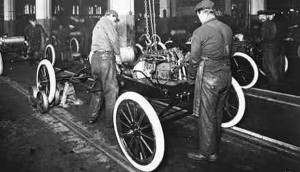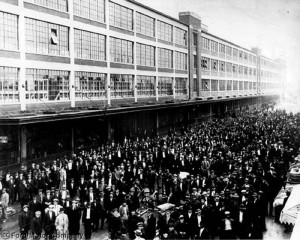It may be one of the most important sites in automotive history — the home of the first moving assembly line and the place where workers first were offered $5-a-day wages — but today, there are few signs to show the significance of the old Ford plant in the struggling Detroit suburb Highland Park beyond the Model T name on an adjacent shopping center.
That could change if a Motor City community and economic development group has its way. The Woodward Avenue Action Association is launching a new crowd-source fundraiser intended to not only save the historic factory but help turn it into a tourist and learning center.
Designed by legendary architect Albert Kahn and once known as the Crystal Palace because of its large windows and abundant natural light, the Highland Park Assembly Plant was actually the third Ford Motor Co. factory and the second to produce the Model T. But with huge demand for his “Tin Lizzie,” Henry Ford desperately needed to increase production.

Ford began offering $5-a-day wages to reduce high worker turnover - and to boost demand for the Model T.
He also needed to ensure a reliable source of labor at a time when workers routinely quit due to the grueling demands of the automotive assembly line. That led the industry pioneer to begin offering $5-a-day wages. But Ford had another motive in mind. It also created a new class of increasingly affluent customers who he rightly assumed would also buy the Model T rather than taking the street car to work.
The factory first opened in 1910 but Ford continued to struggle with booming demand for the little car. He came up with an idea reverse-engineered from the slaughterhouses of the Midwest where carcasses where pushed along a conveyor, each worker hacking off a specific slice of meat. Highland Park began pulling partially assembled Model T bodies along a conveyor – initially by rope – workers at each station assigned to complete a specific task.
(Happy Birthday, dear Henry. Ford founder would turn 100. Click Herefor the story.)
The move helped Ford steadily reduce production costs, dropping the price of the flivver from $800, when it was first introduced, to just $300 by the end of its run.
The plant’s taxes and jobs helped turn the surrounding community into one of the most affluent in the country, but despite its original breakthroughs, the multi-story plant grew increasingly outdated and what was once described as “the factory that changed the world” was largely abandoned by the late 1920s as Ford Motor Co. opened its even more massive factory complex along Detroit’s Rouge River.
Some component and tractor assembly operations continued for a while but the plant has largely been abandoned, with some portions surviving as a company storage depot, and section as a clothing warehouse. The surrounding suburb has also faded away and was placed under emergency financial management for several years due to its fiscal problems.
Despite being added to the National Historic Landmark registry in 1978, there have been concerns the old Model T plant could suffer the same fate as so many other once-prosperous Detroit factories – such as the Packard plant a few miles away that has been steadily collapsing, the prospects of saving it growing increasingly dim.
(Old Packard plant may come crashing down. Click Here for more.)
The Woodward Avenue Action Association’s new crowd-sourcing campaign is an initially modest one. The group, known as WA3, needs $550,000 to acquire several of the remaining buildings on the property. It has already received more than $400,000 in grants and now hopes to raise another $125,000 to secure the purchase.
Eventually, organizers say, they will need still more cash to begin restoration and renovation. Several options are under study for the building’s future, including a museum and learning center.
The “$5 A Day” campaign has a deadline of September 19th to complete the initial financing package. It could prove especially appropriate as that deadline comes just weeks before the 100th anniversary of the moving assembly line which, a statement from Ford notes, began operating on October 7, 1913, “creating and defining the industrial age.”
Those who want to donate to the $5 a Day campaign can call call 248-288-2004 or visit www.woodwardavenue.org.


I hope they are successful. The Ford empire could certainly save this historic complex.